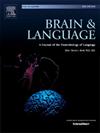Distinct and overlapping neural correlates of English L2 and coding learning in Chinese preschoolers: An fNIRS study
IF 2.3
2区 心理学
Q1 AUDIOLOGY & SPEECH-LANGUAGE PATHOLOGY
引用次数: 0
Abstract
This fNIRS study investigated the neural correlates of English L2 vocabulary and coding learning in 51 Chinese-speaking preschoolers (28 boys; M age = 5.78 years, SD age = 0.92). We hypothesized that L2 vocabulary learning would engage language-related brain regions while Coding would activate visuospatial areas. Results revealed distinct activation patterns: L2 vocabulary learning elicited decreased activation in right prefrontal regions (BA10, BA46), potentially reflecting increased neural efficiency, while coding increased activation in left prefrontal and premotor areas (BA6, BA9, BA44), consistent with visuospatial and planning demands. Functional connectivity analyses revealed stronger interhemispheric connectivity during word learning. Chinese literacy skills negatively correlated with brain activation during L2 word learning, suggesting greater neural efficiency in children with stronger L1 skills. This relationship was less robust for Coding. These findings elucidate the distinct neural substrates of early language and coding acquisition and inform educational strategies.
中国学龄前儿童英语第二语言与编码学习的不同和重叠的神经关联:一项fNIRS研究
本研究探讨了51名汉语学龄前儿童(男孩28名;M年龄= 5.78岁,SD年龄= 0.92)。我们假设二语词汇学习将涉及语言相关的大脑区域,而编码将激活视觉空间区域。结果显示了不同的激活模式:第二语言词汇学习引起右侧前额叶区域(BA10, BA46)的激活减少,可能反映了神经效率的提高,而编码引起左侧前额叶和运动前区域(BA6, BA9, BA44)的激活增加,与视觉空间和规划需求一致。功能连通性分析显示,在单词学习过程中,大脑半球间的连通性更强。汉语读写能力与第二语言词汇学习过程中的脑激活呈负相关,表明母语能力越强的儿童的神经效率越高。这种关系在编码中就不那么牢固了。这些发现阐明了早期语言和编码习得的不同神经基础,并为教育策略提供了信息。
本文章由计算机程序翻译,如有差异,请以英文原文为准。
求助全文
约1分钟内获得全文
求助全文
来源期刊

Brain and Language
医学-神经科学
CiteScore
4.50
自引率
8.00%
发文量
82
审稿时长
20.5 weeks
期刊介绍:
An interdisciplinary journal, Brain and Language publishes articles that elucidate the complex relationships among language, brain, and behavior. The journal covers the large variety of modern techniques in cognitive neuroscience, including functional and structural brain imaging, electrophysiology, cellular and molecular neurobiology, genetics, lesion-based approaches, and computational modeling. All articles must relate to human language and be relevant to the understanding of its neurobiological and neurocognitive bases. Published articles in the journal are expected to have significant theoretical novelty and/or practical implications, and use perspectives and methods from psychology, linguistics, and neuroscience along with brain data and brain measures.
 求助内容:
求助内容: 应助结果提醒方式:
应助结果提醒方式:


